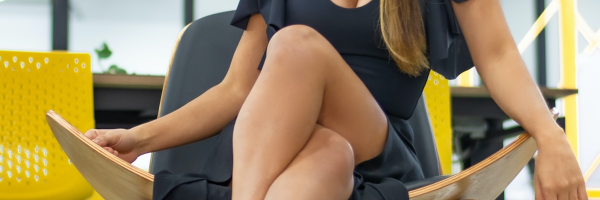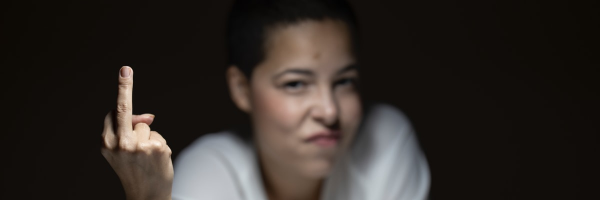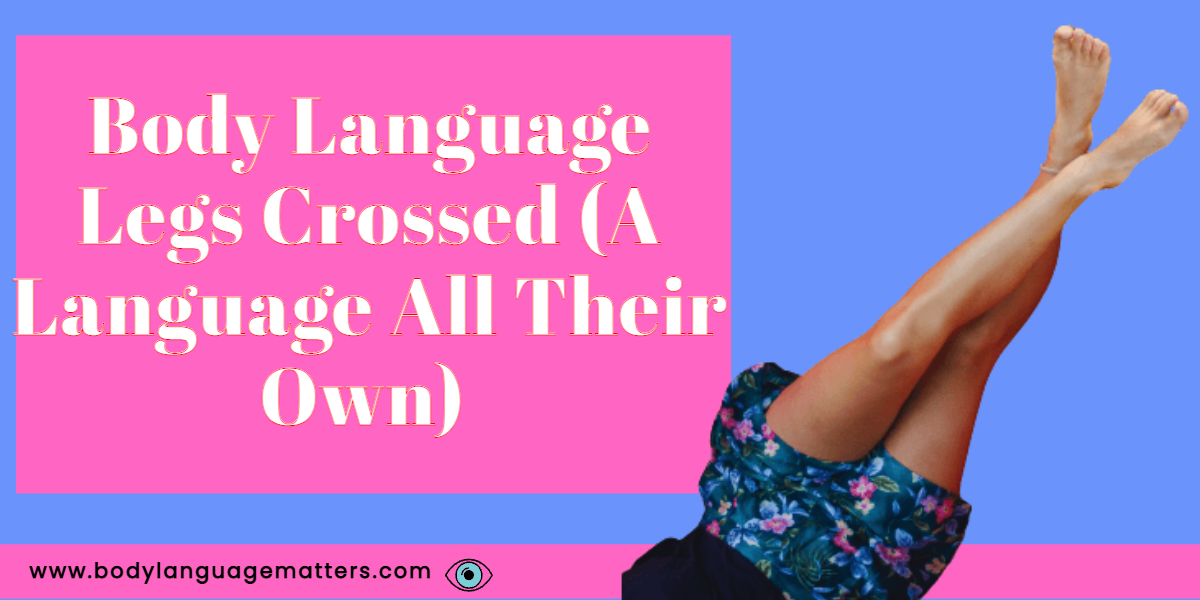So you have spotted someone crossing their legs and want to figure out what is going on with them? Well, you have come to the right post to try to understand why a person would cross their legs in the first place.
Crossed legs can mean many different things, depending on the context of where you see or witness the legs being crossed. For example, if a guy crosses his legs while talking to you, he may be tired. The things to keep in mind are where he is, what time of day it is, what conversations are going on around him and with whom. These will give you the clues you need to understand his body language and the people around him or her.
Crossing the legs can have many different meanings such as discomfort or using them as a barrier whilst sitting to signal insecurity, fear, or concern. The body language cue can also indicate comfort when standing with the leg crossed or crossed on top of the other, which may mean that the person feels confident and in control.
When we notice someone crossing their legs, we can’t take this one movement to mean a positive or negative body language cue. We need to look for clusters of information, shifts from comfort to discomfort, or becoming more agitated or more comfortable
Reading people’s non-verbals the first thing we must do is baseline their behavior in order to get a true read on their body language. The reason we have to baseline someone first is that we are looking for shifts from their natural body language. I suggest you take a look at How To Read Body Language (The Correct Way) for a more detailed understanding. Next, we will take a look at the most common meanings of crossing the legs in body language.
- What Does Sitting With Your Crossed Legs Mean In Body Language?
- Body Language Crossed Legs Man
- Body Language Crossed Legs Female
- Body Language Crossed Legs While Standing
- Body Language Crossed Legs Figure 4
- Positive Body Language Crossed Legs Etiquettes in Positive Body
- Negative Reasons Somone Would Cross Their Legs.
- Does A Woman Sitting Cross-Legged Imply Arrogance
- What Does It Mean When A Woman Crosses Her Legs While Standing
- Body Language Crossed Arms And Legs
- Can We Make Reliable Judgments Based On Crossed Legs?
- Is crossing your legs unhealthy
- Is it bad to stand with your legs crossed
- Why are crossed legs attractive
- Summary
What Does Sitting With Your Crossed Legs Mean In Body Language?

People who cross their legs at the knee and sit with the ankle on their other thigh are generally confident and feel comfortable in their surroundings. People usually sit with their legs crossed when they’re feeling confident or relaxed.
They don’t see any threats or danger because if the legs are crossed they can’t quickly move into a more defensive stance. But as stated above context is king, we need to read other pieces of information in order to get a true understanding. Body Language Crossed Legs Man
Crossing the legs while sitting can also be seen as a negative body language cue. It can be used as a barrier to protect one’s body when they have seen or heard something they don’t like. You will usually see this as the ankles lock together when something negative or something that is said that is controversial is being discussed.
It can also show or indicate composure or they could be mirroring the other person to build rapport. This body language cue, like all others, depends on the context surrounding the movement such as crossed leg position, sitting position, facial expressions and other leg body language cues.
Body Language Crossed Legs Man

When you cross your legs it indicates that you are confident and want some space from the other person or people around you – it is an act of self-preservation showing that you don’t need anything from them at that moment.
It can also show or indicate composure or they could be mirroring the other person to build rapport. Typically, if you see a man’s legs crossed, it means he’s comfortable.
Body Language Crossed Legs Female

Women use gestures to cover up the front area of their bodies because skirts and dresses reveal too much. To women, this becomes a habit and that means you will see it in women even if they are wearing trousers.
Crossing one’s legs at the same time is used as a signalling method to build rapport. Women tend to do this with their friends, as well as for attracting partners.
Body Language Crossed Legs While Standing

When standing, body language is often more complex than when seated. We can learn a lot from how they stand and maintain their balance.
In the standing position, the dominant leg is usually placed in front of the other leg. The person will use their hands to help maintain balance or grip on objects close by. They will also be more likely to cross one or both of their legs.
When you see crossed legs while standing, this means that they are in control of their environment and feel safe. Body Language Crossed Legs Figure Four
Body Language Crossed Legs Figure 4

Body language is often misunderstood, but it’s an important part of communicating effectively.
Crossed legs can represent a person who feels they don’t have the floor and they are not in charge of the conversation.
Figure 4 is a chair position that usually signals that the person wants to be in control or has authority and doesn’t mind exposing their genitals this is typically seen in male behavior.
The 4-figure can also be seen as an insult, as it shows a dirty uplifted sole. The shoe could touch an adjacent person’s clothing, a sign of lack of respect. In some cultures, the 4-figure sitting position is considered an insult because of the exposure of the dirty sole.
Positive Body Language Crossed Legs Etiquettes in Positive Body
Enthusiasm and excitement are communicated through open arms, a smile, and a big welcoming gesture if you see these whilst someone is crossing their legs then this is a good thing as they are displaying good open body language cues.
Negative Reasons Somone Would Cross Their Legs.
In contrast, if someone has their arms crossed it can be seen as a sign of being closed off to other people. It’s also the same if they turn away from others or cross their legs – this shows that they don’t feel connected with what other people are saying or doing.
The appropriate body language etiquette depends on the message you’re trying to send and also on being aware of your surroundings thinking relaxation or submissive behavior to give you clues.
Does A Woman Sitting Cross-Legged Imply Arrogance

Depending on the culture or contact, a woman crossing her legs could be seen as disrespectful or arrogant. If a woman were to cross her legs in front of her boss in Asia, this would send a strong negative signal. Or if you say something she doesn’t like, it could be seen as negative from her point of view.
What Does It Mean When A Woman Crosses Her Legs While Standing

This is a sign of confidence. She has taken up space in order to feel comfortable. She is just trying to be attractive to the opposite sex.
It is a sign of confidence when a woman takes up space. It is not because she is being bossy. It is because she needs to feel comfortable in her own skin. Girls are told that they should be small, which can make it difficult to let go of that idea.
Body Language Crossed Arms And Legs
Crossing your arms and legs is a defence mechanism that we take when we feel threatened. Crossing arms and legs can also be interpreted as disagreement with what the speaker is saying we mainly see this nonverbal cue when sitting down.
This could be barriers, blocking or shielding, closed body language, or defensive body language, depending on the context.
Can We Make Reliable Judgments Based On Crossed Legs?
Can we make reliable judgments based on crossed legs? It is a common human gesture to cross one leg over the other at the ankle, but can we accurately read people based on this body language?
It’s a common sight to see someone sitting with their legs crossed, but can we make reliable judgments based on this position? The answer is complicated. While crossing your legs at the ankle is generally considered polite, crossing one leg over the other at the knee is often seen as a power move. This is because the position takes up more space and can make the person seem more assertive.
However, it’s important to remember that body language is just one part of the equation – so don’t put too much stock in any single gesture.
Is crossing your legs unhealthy
Crossing your legs is not generally considered to be unhealthy. However, if you have a condition such as varicose veins, crossing your legs can put additional pressure on the veins and may worsen the condition. Additionally, if you have joint pain or other mobility issues, crossing your legs may be uncomfortable or make it difficult to get up from a seated position. If you are concerned about the healthiness of crossing your legs, talk to your doctor.
Is it bad to stand with your legs crossed
Body language is the unspoken communication that we use to express ourselves through our physical movements and posture. When we cross our legs while sitting, it can be interpreted in a few different ways. Some people see it as a relaxed and comfortable position, while others view it as closed-off and even rude. If you’re not sure how your crossed legs are being perceived, it’s best to err on the side of caution and avoid crossing them.
Why are crossed legs attractive
There are many reasons why crossed legs may be considered attractive. For one, crossed legs can give the appearance of a slim figure. Additionally, crossing your legs can make you look more graceful and elegant. Additionally, many people find the “foot pop” that often occurs when crossing their legs to be quite attractive or hanging a stiletto from a single foot whilst the legs are crossed is deeply attractive.
Final Thoughts
Crossed legs have many meanings, but we should always analyze them with other information in order to reach a well-founded conclusion. Crossing one’s legs can be seen as a positive or negative behavior depending on the context. It’s a good nonverbal cue to keep in the back of one’s mind when reading people.
There are no certainties when it comes to reading body language, but crossing one’s legs is certainly one of those behaviors that we should take note of when we see it or notice it in another person. If you want to learn more, please visit my other complete guide about reading body language.

